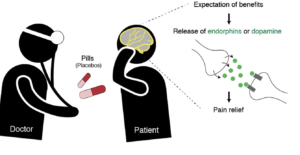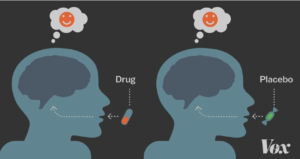![[SITN]Pinch_Fig_1_draft_2](https://biopharmanotes.com/wp-content/uploads/2020/03/placebo-effect-678x381.jpg)
Introduction
- Placebo is derived from Latin term which means ‘I may please you.’ Placebos are defined as sham or fake treatment (bread pills, inert tonics, saline solution) used by physicians to please anxious patients. It is known fact that patient get some immediate relief as soon as he meets doctor or doctor’s medicine is administered, irrespective of its drug content. It may be due to their faith in doctor.
- Henry Knowles Beecher (1904–1976), is one of the first researcher to find out about placebo effect. He noted that soldiers wounded in world war II asked for analgesics less frequently than patients wounded in similar way in civil hospitals. He reasoned that civilians were more worried about their social and financial situation whereas in case of soldiers being wounded means they have survived, and they would be removed from combat zone and would be treated well. Thus, he opinioned that threatening consequences anticipated by the civilian patients may be the reason for their demand of analgesics. He claimed that ‘placebos have a high degree of therapeutic effectiveness in treating subjective responses’ and can also have toxic effects.
- A placebo is usually an inert substance like starch or lactose. It can often produce relief of subjective symptoms like anxiety, headache, pain, breathlessness. Sometimes objective responses like decrease or increase in neutrophil and eosinophil is also seen. Nowadays placebos are generally used for two main purposes:
- As therapeutic agents that work psychologically.
- In clinical trials of drugs to eliminate the possibility that the benefit of drug is solely due to chance.
Classification of placebo
- Placebo can be classified into two types. A “pure” placebo is an inert substance without known pharmacologic effect. It may be sugar pills and saline injections. “Impure” placebos are prescribed medications that have a known therapeutic effect on some illnesses but not on others. Examples of impure placebos include antibiotics and vitamins.
- For psychological disorders, particularly depression, it has been shown that pill placebos are nearly as effective as active medications whereas psychotherapies are more effective than psychological placebos. However, it is shown that when properly designed, psychological placebos are as effective as accepted psychotherapies.
Mechanism of placebo effects
- According to different researches done, the mechanisms of placebo response or placebo effects may be mainly classified into psychological and neurobiological effect. Various other researches into placebo response have found growing integration of both neurobiological and psychological effects.
- A 2014 study led by Kaptchuk and published in Science Translational Medicine explored mechanism of placebo effect by observing how people reacted to migraine pain medication. They were divided into three groups. One group took a migraine drug labeled with the drug’s name, another took a placebo labeled “placebo,” and a third group took nothing. The researchers discovered that the placebo was 50% as effective as the real drug to reduce pain after a migraine attack.
- It was speculated that a driving force beyond this reaction was the simple act of taking a pill. According to Kaptchuk, even though the people know that it’s not medicine, their thinking of taking medicine as a positive healing effect stimulate the brain into thinking the body is healed.
1) Neurobiological effects:
- One possible mechanism of placebo effect is that placebos produce endorphins. Endorphins are any of a group of endogenous peptides found especially in the brain that bind chiefly to opiate receptors and produce some pharmacologic effects, such as pain relief, like those of opiates.
- In a research done in 1978, all patients were given a placebo following a dental procedure for pain relief. For the second treatment, the patients were given either another placebo or naloxone. Among the patients who received the naloxone, only those who responded to the first placebo experienced increased pain. The research demonstrates that placebos produce actual relief from pain in the form of endorphins and naloxone, a drug that blocks opioid analgesia, also blocks placebo analgesia.

Figure 1- Neurobiological effect involved in placebo effect (source- Harvard.edu)
Psychological effects:
- Another possible explanation for the placebo effect are conditioned response. It had been recognized through a history that a positive emotional state regarding a treatment is associated with a better response to that treatment.
- In a study done in 1990, a group of subjects were given local electric shock in wrist to generate pain, the stimulus was reduced then. After this, researchers applied a sham analgesic cream, and told the subjects it was a mild analgesic. In a second trial, the researchers applied the cream but returned the electrical stimulus to its original level. The subjects reported that they feel less pain in the second trial compared to the pain in the original stimulus. The application of the placebo cream with which the subjects had already had a positive experience led the subjects to an expectation of decreased pain.

Figure 2- Psychological reason of placebo effect (Source- vox.edu)
Use of placebo effects in clinical trials
- Placebo are used in clinical trials to eliminate chances of effect of biasness of physician and patient. In clinical trials the results of the new drug are compared with those obtained from the placebo. The researchers can see how much positive effects patients have when they are taking new medicine, not just due to placebo effect but due to pharmacological effect of medicine.
- The placebo-controlled trial is widely regarded as the gold standard for testing the efficacy of new treatments. Such clinical trials are called ‘placebo-controlled study’ and its control is of the negative type. A study in which control used is previously tested standard treatment, rather than no treatment is called positive control study. New drugs are approved not only when patients respond to them, but they should also show greater effect than that of placebo.
- Placebo is mostly used in phase 3 trial. If neither the patients nor the researchers know who is getting a placebo and who is getting the treatment, it is called double blind study. In this kind of study, patients don’t know what they’re getting, so their belief about what will happen doesn’t affect the results. As the researchers also don’t know, they can’t hint to patients about what they’re getting, and they also won’t affect results through their own biased expectations about what the results will be. If researchers know who is getting the placebo and participants don’t know it is called single-blind trial.
- The patients who are receiving placebo in any clinical studies are always notified of this possibility during the informed consent process before joining a trial. This cover any potential risks associated with the control group treatment, and what percent of patients are placed in a group that doesn’t receive the study treatment.
Placebos are not used in some clinical trial
- Placebos are not used in every clinical trial. Generally, they are not used in a study in which not having an effective therapy would put patient’s life in risk. For example, in cancer clinical trials, placebos are almost never used.
References
- Karin Meissner, Niko Kohls, Luana Colloca. Introduction to Placebo effects inmedicine: mechanisms and clinical implications.. Philosophical Transactions of the royal society B. 366(1572).
- Voudories NJ, et al. The role of conditioning and verbal expectancy in the placebo response. Pain. 1990; 43: 126-127.
- Talbot M, The placebo prescription. NY Times. Jan. 9, 2000:35.
- Levin JD, et al. The mechanism of placebo analgesia. Lancet. 1978; 23: 654.
- Simmonds A. Ethics of placebo-controlled trials in developing countries: The search for standards and solutions. The Journal of Undergraduate Writing Program. New York: Columbia University; 2009-2010. 1–7.
- Di Blasi, Zelda; Harkness, Elaine; Edzard, Ernst; Georgiou, Amanda; Kleijnen, Jos). Influence of context effects on health outcomes: a systematic review. The Lancet. 357 (9258): 757–762.
- Finniss, Damien G., Benedetti, Fabrizio. Mechanisms of the placebo response and their impact on clinical trials and clinical practice. Pain: March 2005; 114(1): 3-6. Volume 114 – Issue 1 – p 3-6.
- The power of the placebo effect. Treating yourself with your mind is possible, but there is more to the placebo effect than positive thinking. Updated: August 9, 2019. Published: May, 2017. Harward Health Publishing, Harward Medical School.
- The Placebo effect: An Interdisciplinary Exploration.
- Pharmacology and Pharmacotherapeutics book, R.S. Satoskar. Page no- 86-88.
- Goodman and GILLMAN’S Manual of Pharmacology and Therapeutics. Page no- 71-72.
- A Textbook of Clinical Pharmacology and Therapeutics. Page no- 88-89.